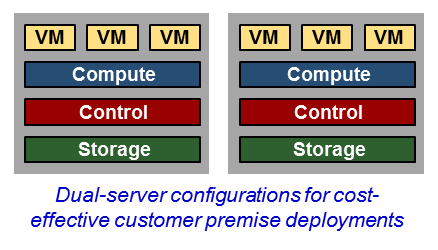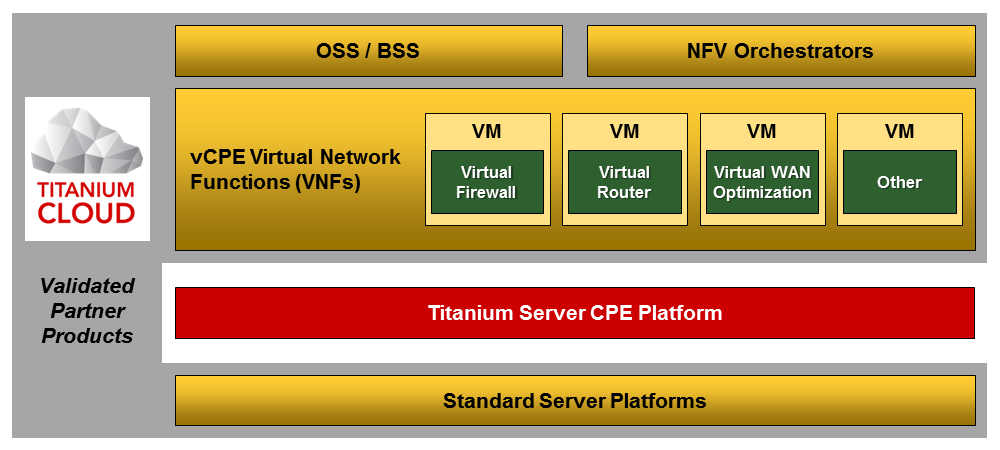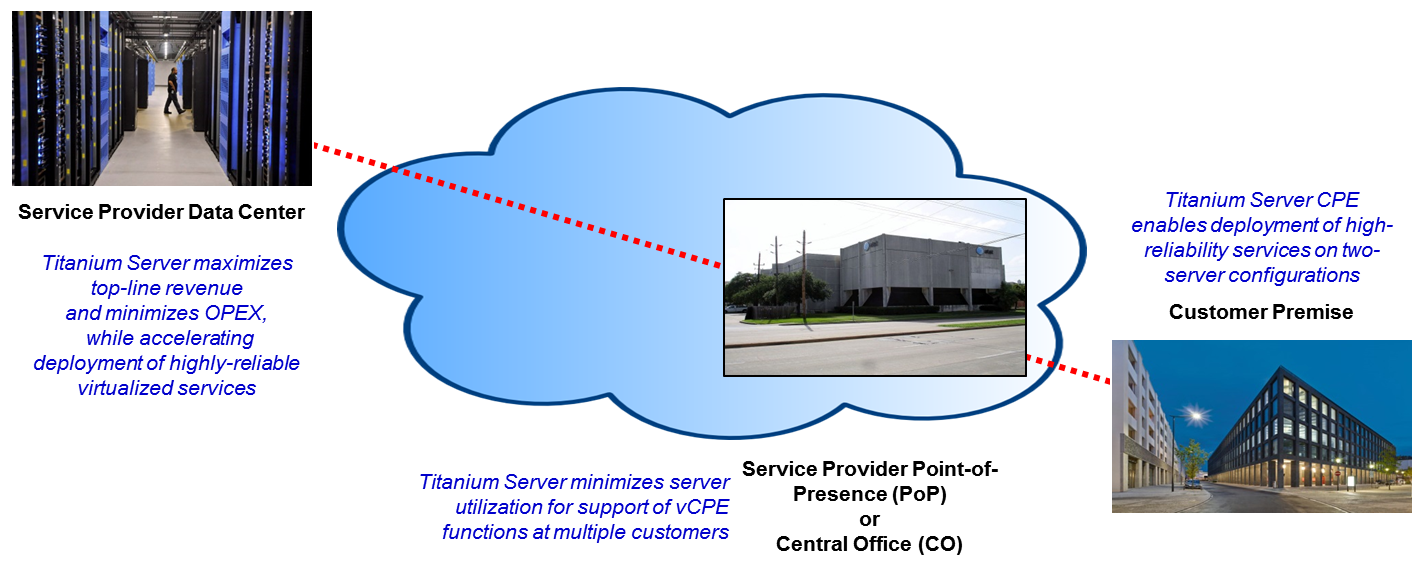Over the past year or so, a strong consensus seems to have emerged within the telecom industry that the #1 use case for early deployments of Network Functions Virtualisation (NFV) will be Virtualised Customer Premises Equipment (vCPE).In this post we’ll briefly summarise why vCPE represents such an interesting business proposition for service providers and introduce Wind River’s new solution for this application, Titanium Server CPE.
Applicable to both enterprise and residential scenarios, vCPE replaces physical hardware appliances traditionally located at the customer premise that provide connectivity, security and other functions. By deploying general-purpose compute platforms based on industry-standard servers, either locally at the customer’s premise or in a centralised data center, service providers can remotely instantiate, configure and manage functions that were once deployed on dedicated hardware platforms.
This virtualisation of CPE functions reduces OPEX through more efficient utilisation of compute resources, through increased agility in the deployment of services and through the elimination of “truck rolls” required to update and maintain equipment at remote locations.
No wonder CFOs are excited
Industry analysts have studied the economics of vCPE in detail. A fascinating recent report from Analysys Mason, “vCPE services business case: potentially billions of dollars payback for fixed CSPs,” provides a wealth of information on the ROI for both enterprise and residential vCPE.
Among their most interesting findings, Analysys Mason calculates that enterprise vCPE (otherwise known as virtual Business CPE “vBCPE”) can generate new revenue of $1.4B in North America and Western Europe over a 5-year period, for service providers who are early adopters of this technology.
vBCPE offers them a Return on Investment (ROI) of 156% along with 47% annual OPEX savings per site and a payback period of just 3 years. Those compelling numbers result from a combination of the use of standard hardware, operations support system (OSS) automation and customer self-provisioning.
For residential applications, the primary benefit of vCPE is cost reduction. Service providers can increase margins, while also allowing customers to self-provision their upsell services and add video with cloud-based digital video recording (cloud DVR) and virtual set-top boxes (vSTB). For first-movers, Analysys Mason estimates $1.3B in net cost savings over a 5-year period, with ROI of 49%, a 5-year payback period and a massive 82% cost savings per household.
Numbers like these indicate a business value proposition for vCPE that is much more clear-cut than for many other NFV functions and services. As a use case, vCPE also has less dependency on the complexities of Management and Orchestration (MANO), where the standards are still in flux and there’s a lack of consensus on which approach will gain the most traction.
So it’s easy to see why Finance executives at service providers are excited about vCPE. From the Operations side however, important questions have been raised about achieving service reliability while maximising cost reductions. Wind River’s recently-announced Titanium Server CPE platform addresses this challenge.
Multiple hosting scenarios
Service providers typically need to support three primary hosting options for the Virtualised Network Functions (VNFs) that comprise a vCPE: CPE 1
- The service provider’s data center, supporting many thousands of customers over a wide geographical area.
- The service provider’s Point-of-Presence (PoP) or Central Office (CO) locations, serving multiple local customers.
- The customer premise, which is whether the traditional physical appliances are located.

In the first two scenarios, service providers need to run the vCPE remotely on an NFV Infrastructure (NFVI) platform that guarantees Carrier Grade uptime for the services in order to minimise revenue impacts from downtime, while at the same time optimising server utilisation to maximise OPEX savings compared to physical infrastructure.
Wind River’s Titanium Server NFVI platform was developed to address exactly these requirements and has achieved great industry traction since its launch a couple of years ago. In a service provider data center, PoP or CO, a typical installation will involve tens, hundreds or thousands or servers. Titanium Server allows a large number of compute node servers to be controlled by as few as two control node servers, which is key to maximising the overall utilisation of the infrastructure.
The customer premise scenario presents different challenges, particularly for enterprise (vBCPE) deployments.
Business CPE needs high reliability and low cost
For many vBCPE deployments at enterprise customers, low cost is critical to justify the replacement of traditional physical network appliances. The vBCPE performance requirements can in many cases be met by a single server, especially with the processing bandwidth now available in the latest Intel® Architecture platforms. At the same time, enterprises require high reliability for networking services, which are viewed as business-critical functions.
CPE 2For enterprise deployments that are both low cost and highly reliable, the ideal solution is to deploy the vBCPE on a two-server configuration. To minimise cost, each server runs all the necessary compute, control and storage functions.
The dual-server approach allows for an active-standby approach to reliability, guaranteeing service continuity in the event of a failure of either node.
Wind River’s recently-announced Titanium Server CPE platform is the industry’s first NFVI solution that allows service providers to ensure this balance of low cost and high reliability.
Introducing Titanium Server CPE
CPE 3The new Titanium Server CPE platform builds on the proven, well-established Titanium Server NFVI platform.
By leveraging the Titanium Server CPE platform, service providers can deploy cost-sensitive NFV applications such as a virtual Business CPE on only two servers. Each server runs all the compute, control and storage functions, while delivering best-in-class VNF performance to maximise the number of users supported per server and thereby also maximise OPEX savings.
At the same time, Titanium Server CPE allows service providers to maintain full Carrier Grade uptime for the vBCPE services. As we’ve discussed in previous posts, this enables them to minimise any revenue impact resulting from Service Level Agreement (SLA) penalties triggered by service downtime.
Titanium Server CPE is available now and it’s the obvious NVFI platform for service providers to choose when deploying vBCPE functions hosted on premise at their enterprise customers.
Industry-leading ecosystem brings virtual Business CPE reference design
In December, Wind River introduced a reference design for a virtual Business CPE, following extensive collaboration with four Network Functions Virtualisation (NFV) software partners. Partnering with Brocade, Check Point, InfoVista and Riverbed, we have demonstrated a complete, multifunction vBCPE running on Titanium Server CPE.
The vBCPE reference design includes virtual network functions (VNFs) from these four partner companies. All these VNFs have been on-boarded to run on Titanium Server CPE through these companies’ collaboration in the Wind River Titanium Cloud ecosystem.
Other goodies in the latest Titanium Server release
Titanium Server CPE was launched at the same time as the latest release of Titanium Server. That release includes a wide range of new features and functions, which are too numerous to cover here but were outlined in a recent post.
Please feel free to contact us to talk about any of these topics or to suggest other areas that we should investigate. The industry is moving quickly to focus on early use cases like virtual CPE that will deliver strong Return on Investment and Wind River will continue to deliver the NFVI platform features that are required for these applications.
Comment on this article below or via Twitter: @ VanillaPlus OR @jcvplus







